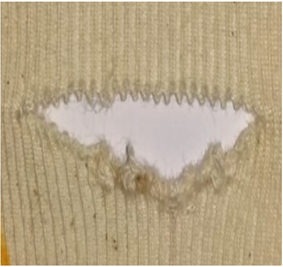Exploring weft knit fabric defects based on their presence and quality impact: A case study
DOI:
https://doi.org/10.25367/cdatp.2020.1.p57-64Keywords:
knit, defect, quality, 4-point system, weft, fabric, influentialAbstract
While addressing grey fabric quality in a renowned circular weft knitting mill of Bangladesh, the authors experienced some questionable approach practiced by knitters. The subjective nature of defect detection by knitters/inspectors often time causes wrong emphasizing on frequently occurring defect(s) instead of focusing on influential defect(s) and subsequently, employing wrong quality control approach to minimize the grey fabric defects. Knit fabric defects (e.g., hole, stain, press-off, gout, miss knit, barrè, tucking, etc.) should be assessed by type, fault coverage, gravity and the frequency of occurrence instead of focusing only on frequency of occurrence in the fabric. In this study, grey weft-knitted fabric quality is investigated based on influential defects instead of frequently occurring defects. Quality data of single jersey, fleece and 1X1 rib were gathered and analyzed from an established knitting factory in Bangladesh over three months duration. A fabric inspection machine and 4-point inspection method were employed in this study. Gout was found as the most frequently occurring defect for each fabric type but not influential for rib fabric. For a significant amount of knitted fabrics, totaling of 55,524.91 m2 inspected fabric, the most occurring defects were ranked as gout, press-off, hole, miss knit, stain, and tucking and influential defects (based on inspection points) were ranked as gout, press-off, hole, stain, miss knit, and tucking (highest to lowest). In the inspection report, the knitter/inspector mistakenly categorized gout as the most occurring as well as the most influential defect for 1X1 rib fabrics and suggested remedies accordingly.
References
Bharadwaj, R. (2019, November 21). Artificial intelligence in the textile industry – Current and future applications. Retrieved from https://emerj.com/ai-sector-overviews/artificial-intelligence-in-the-textile-industry- current-and-future-applications/
Ben Abdessalem, S., Elmarzougui, S., Mokhtar, S., & Heni, R. (2008). Parameters influencing plain knitted fabric spirality. Indian Textile Journal, 4, 29-34.
Gebru, K. (2014). Identifying defect causes of weft greige knitted fabric: The case of MAA-garment & textiles Factory (Master’s thesis, Mekelle University).
Hossain, A., Moin, C., & Mahabubuzzaman, A. (2011). Determining the most frequent defects for circular weft knitting fabric machines: A case study. Journal of Innovation & Development Strategy, 5(2), 10-17.
Taher, A., Rahman, M., Jahangir, A., Mia, S., & Ashaduzzaman, M. (2016). Study on different types of knitting faults, causes and remedies of knit fabrics. International Journal of Textile Science, 5(6), 119-13.
Sadi, M. S., Nahar, N., Shakhawat, H. M., & Sajib, S. H. (2018). Amendment of Finished Knitted Fabric Quality by Reducing the Intensity of Defects and Improvement Techniques. American Journal of Materials Science, 8(1), 6-14.
American Society for Testing and Materials (2000). ASTM D5430-13 (2017): Standard test methods for visually inspecting and grading fabrics. ASTM International, USA.
AQF Operations Team (2012, January 20). 4 point system for QC on fabric. [Blog post]. Retrieved from https://blog.asiaqualityfocus.com/qc-fabric/
Clothing Industry. (2017, December 23). Fabric Inspection Systems for Garment Industry [Blog post]. Retrieved from https://clothingindustry.blogspot.com/2017/12/fabric-inspection-systems.html
American Society for Testing and Materials (2016). ASTM D3990-12 (2016): Standard terminology relating to fabric defects. ASTM International, USA.
Iyer, C., Mammel, B., & Schäch, W. (1995). Circular knitting: Technology process,structures yarns, quality. Meisenbach Bamberg, Germany.
International Organization for Standardization (ISO) Technical Committee (2003). ISO/TC 38/SC 20 (2003) ISO 8499:2003: Knitted fabrics — Description of defects — Vocabulary. ISO, Switzerland
U.S. Department of Defense (1973). United States Military Standard-1491 (MIL-STD-1491): Glossary of knitting imperfections. U.S. Department of Defense, USA.

Downloads
Published
Versions
- 2023-05-27 (2)
- 2020-11-15 (1)
How to Cite
Issue
Section
License
Copyright (c) 2020 Md Imranul Islam

This work is licensed under a Creative Commons Attribution-NonCommercial-NoDerivatives 4.0 International License.





